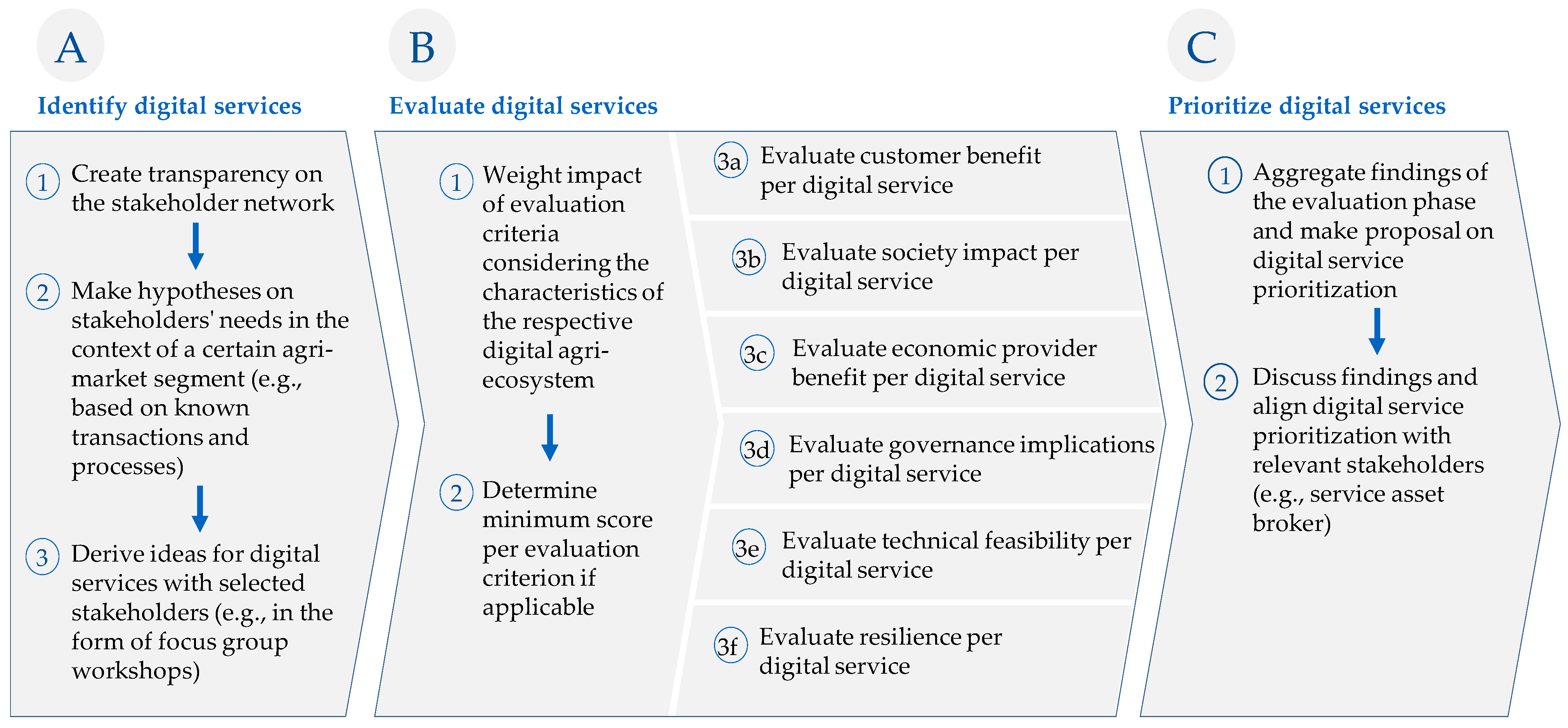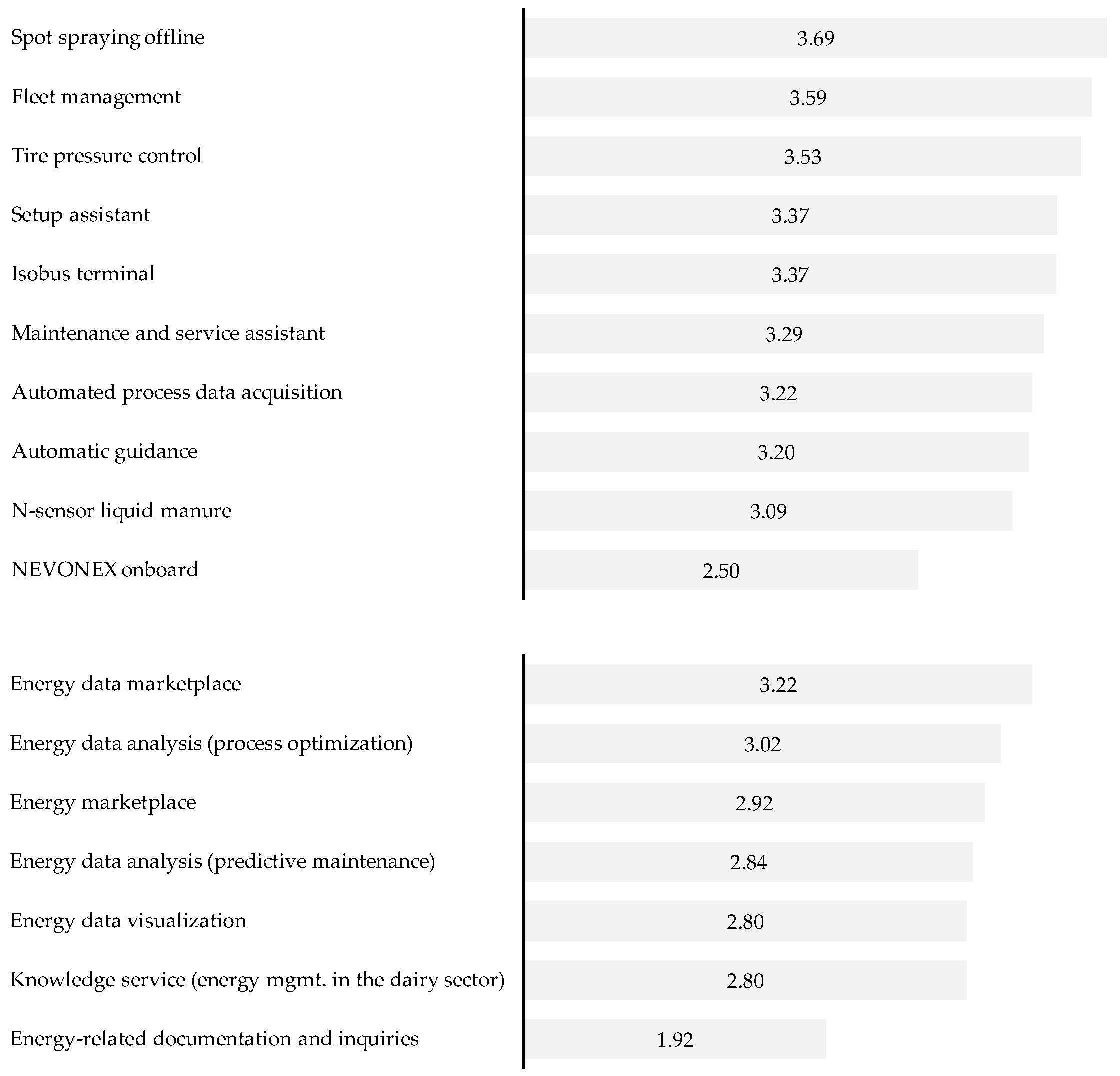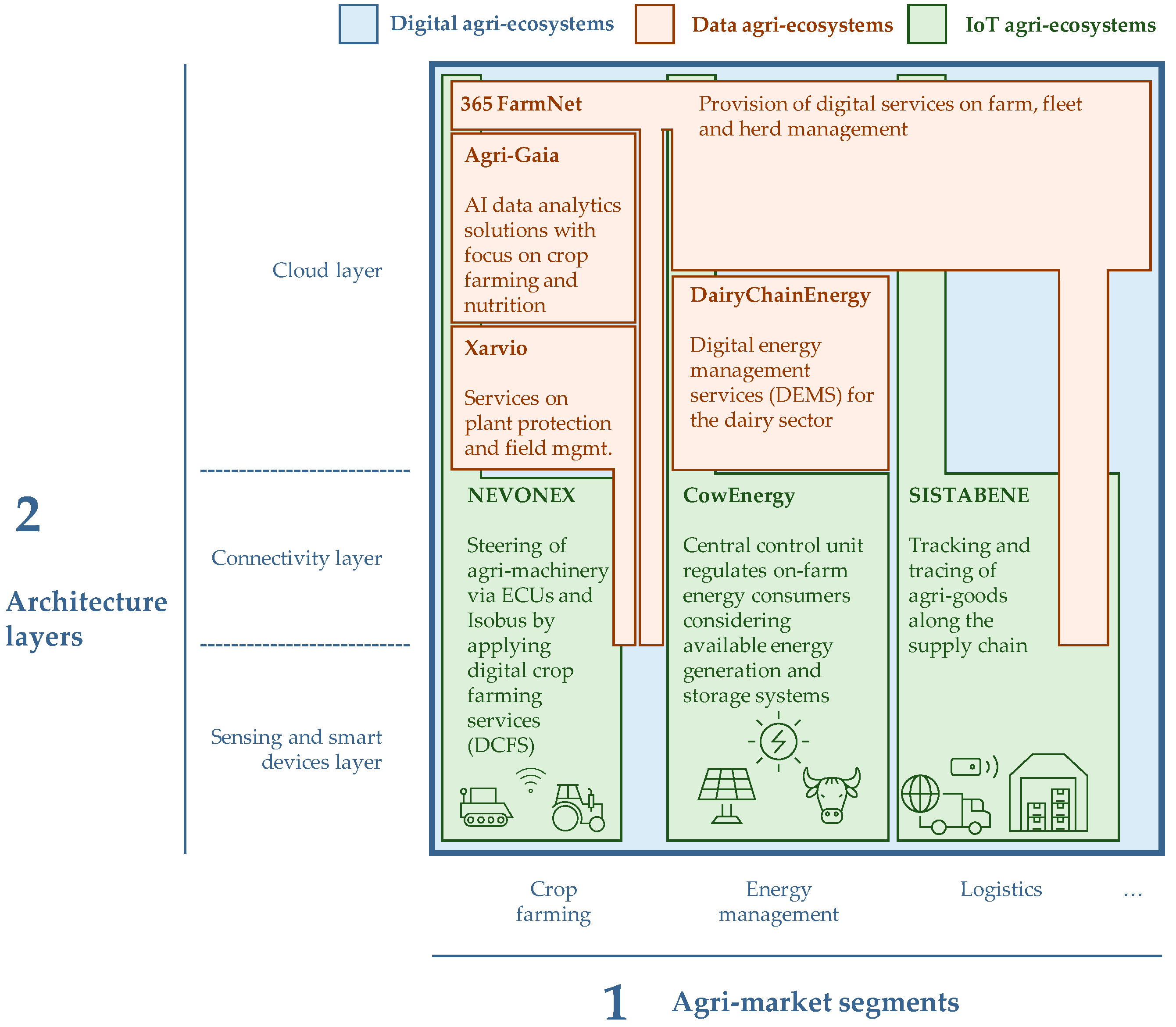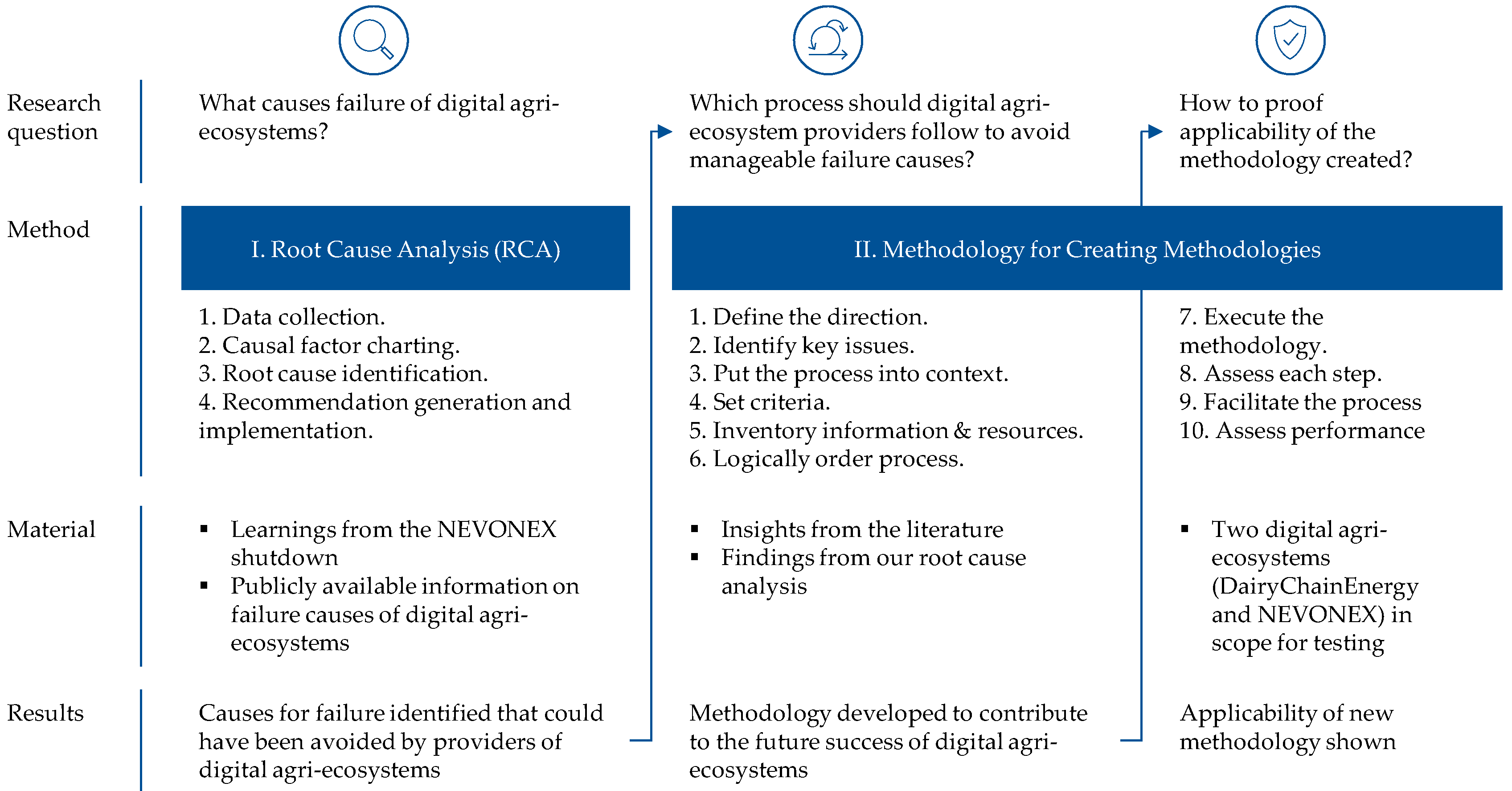How to Successfully Orchestrate Content for Digital Agriecosystems
Abstract
:1. Introduction
2. Materials and Methods
3. Results
3.1. Causality behind Failure of Digital Agriecosystems
3.2. Introducing a Three-Phase Content-Orchestration Methodology for Digital Agriecosystems
3.3. Testing our Methodology: NEVONEX and DairyChainEnergy
4. Discussion
5. Conclusions
Author Contributions
Funding
Institutional Review Board Statement
Data Availability Statement
Conflicts of Interest
References
- Koch, M.; Krohmer, D.; Naab, M.; Rost, D.; Trapp, M. A matter of definition: Criteria for digital ecosystems. Digit. Bus. 2022, 2, 100027. [Google Scholar] [CrossRef]
- Acs, Z.J.; Song, A.K.; Szerb, L.; Audretsch, D.B.; Komlósi, É. The evolution of the global digital platform economy: 1971–2021. Small Bus. Econ. 2021, 57, 1629–1659. [Google Scholar] [CrossRef]
- Better Food Ventures. Farm Tech Market Map: Why It’s Time to Distinguish Farm Tech from the Messy Supply Chain. 2020. Available online: https://betterfoodventures.com/agtech-landscapes/farm-tech-landscape-2020 (accessed on 20 April 2023).
- Dörr, J.; Nachtmann, M.; Linke, C.; Crawford, J.; Ehlers, K.; Balzer, F.; Gandorfer, M.; Gabriel, A.; Pfeiffer, J.; Spykman, O.; et al. Introduction. In Handbook Digital Farming; Dörr, J., Nachtmann, M., Eds.; Springer: Berlin/Heidelberg, Germany, 2022; pp. 1–58. ISBN 978-3-662-64377-8. [Google Scholar]
- Azkan, C.; Möller, F.; Ebel, M.; Iqbal, T.; Otto, B.; Poeppelbuss, J. Hunting the Treasure: Modeling Data Ecosystem Value Co-Creation. In Proceedings of the Forty-Third International Conference on Information Systems, Copenhagen, Danmark, 9–14 December 2022. [Google Scholar]
- Quy, V.K.; van Hau, N.; van Anh, D.; Quy, N.M.; Ban, N.T.; Lanza, S.; Randazzo, G.; Muzirafuti, A. IoT-Enabled Smart Agriculture: Architecture, Applications, and Challenges. Appl. Sci. 2022, 12, 3396. [Google Scholar] [CrossRef]
- Treiber, M.; Oergele, J.-N.; Bell, D.; Bernhardt, H. The NEVONEX ecosystem—Impact assessment of a smart, neutral, open, and quality controlled framework for end-to-end infrastructure in agriculture. In Proceedings of the 2020 ASABE Annual International Virtual Meeting, St. Joseph, MI, USA, 13–15 July 2020; p. 1. [Google Scholar]
- Bernhardt, H.; Höhendinger, M.; Stumpenhausen, J. Development of the Technical Structure of the “Cow Energy” Concept. Agronomy 2021, 11, 1915. [Google Scholar] [CrossRef]
- Münzenmay, M.; Tanimou, M.; Kurre, H. Digital Ecosystem Nevonex for Smart Agriculture. ATZheavy Duty Worldw. 2020, 13, 44–49. [Google Scholar] [CrossRef]
- Mishra, S.; Liang, J.-M. Design and Analysis for Wireless Tire Pressure Sensing System. In New Trends in Computer Technologies and Applications; Hsieh, S.-Y., Hung, L.-J., Klasing, R., Lee, C.-W., Peng, S.-L., Eds.; Springer Nature: Singapore, 2022; pp. 599–610. ISBN 978-981-19-9581-1. [Google Scholar]
- Shumakova, O.; Pomogaev, V.; Skosyreva, N.; Vasyukova, M. Potential of Youth in Digital Ecosystem of Agricultural Sector. WEB 2021, 18, 1311–1325. [Google Scholar] [CrossRef]
- Migende, J.; Sonnen, J.; Schauff, S.; Schill, J.; Mayer-Bosse, A.; Leeb, T.; Stangl, J.; Stöcklin, V.; Kiefer, S.; Pessl, G.; et al. Agronomy Perspective. In Handbook Digital Farming; Dörr, J., Nachtmann, M., Eds.; Springer: Berlin/Heidelberg, Germany, 2022; pp. 191–276. ISBN 978-3-662-64377-8. [Google Scholar]
- Oliveira, M.I.S.; Barros Lima, G.d.F.; Farias Lóscio, B. Investigations into Data Ecosystems: A systematic mapping study. Knowl. Inf. Syst. 2019, 61, 589–630. [Google Scholar] [CrossRef]
- Theunissen, T.; Keller, J.; Bernhardt, H. Mind the Market Opportunity: Digital Energy Management Services for German Dairy Farmers. Agriculture 2023, 13, 861. [Google Scholar] [CrossRef]
- Sobirov, B.; Yekimov, S.; Sitkovska, A.; Iushchenko, L.; Dmytrenko, R. Using Digital Ecosystems in Agriculture. In Ecosystems without Borders; Polyakov, R., Ed.; Springer International Publishing: Cham, Switzerland, 2022; pp. 171–176. ISBN 978-3-031-05777-9. [Google Scholar]
- Elijah, O.; Rahman, T.A.; Orikumhi, I.; Leow, C.Y.; Hindia, M.N. An Overview of Internet of Things (IoT) and Data Analytics in Agriculture: Benefits and Challenges. IEEE Internet Things J. 2018, 5, 3758–3773. [Google Scholar] [CrossRef]
- Arnold, L. Nevonex GmbH Stellt Ende März 2023 Geschäftstätigkeiten ein. 2023. Available online: https://www.agrartechnikonline.de/news/nevonex-stellt-taetigkeit-ein/ (accessed on 22 March 2023).
- Deter, A. Digitale Agrarhandelsplattform Agrando Meldet Vorläufige Insolvenz an. 2022. Available online: https://www.topagrar.com/markt/news/digitale-agrarhandelsplattform-agrando-meldet-vorlaeufige-insolvenz-an-13131228.html (accessed on 22 March 2023).
- Eckelkamp, M. Sun Sets on Granular Agronomy: New Digital Direction at Corteva. 2022. Available online: https://www.agweb.com/news/business/technology/sun-sets-granular-agronomy-new-digital-direction-corteva (accessed on 22 March 2023).
- Marston, J.; Burwood-Taylor, L. BREAKING: Bayer, Microsoft Formalize and Launch Cloud-Based Data Manager, Tools for Agriculture. 2023. Available online: https://agfundernews.com/bayer-microsoft-formalize-and-launch-cloud-based-data-manager (accessed on 22 March 2023).
- Rooney, J.J.; Heuvel, L.N.V. Root Cause Analysis for Beginners; Quality Progress: Milwaukee, WI, USA, 2014; pp. 45–53. [Google Scholar]
- Gawer, A. Digital platforms’ boundaries: The interplay of firm scope, platform sides, and digital interfaces. Long Range Plan. 2021, 54, 102045. [Google Scholar] [CrossRef]
- Steffen, B.; Möller, F.; Stachon, M. Success Factors of Digital Platform Design. ITM Web Conf. 2023, 51, 5001. [Google Scholar] [CrossRef]
- Cusumano, M.A.; Gawer, A.; Yoffie, D.B. The Business of Platforms: Strategy in the Age of Digital Competition, Innovation, and Power, 1st ed.; Harper Business: New York, NY, USA, 2019; ISBN 9780062896322. [Google Scholar]
- Gubanova, A.; Clasen, M.; Theuvsen, L. How do digital agricultural startups achieve critical mass? A qualitative analysis. In 37. GIL-Jahrestagung 2017-Fokus: Digitale Transformation–Wege in Eine Zukunftsfähige Landwirtschaft, Lecture Notes in Informatics; Gesellschaft für Informatik eV: Bonn, Germany, 2017; pp. 61–64. [Google Scholar]
- Theunissen, T.; Keller, J.; Bernhardt, H. Market gap for cross-value chain energy management in the German dairy sector. In Proceedings of the XX CIGR World Congress: Sustainable Agricultural Production—Water, Land, Energy and Food, Kyoto, Japan, 5–10 December 2022. [Google Scholar]
- Bürkel, J.; Zimmermann, A. Service-Dominant Design: A Digital Ideation Method. In Architecting the Digital Transformation; Zimmermann, A., Schmidt, R., Jain, L.C., Eds.; Springer International Publishing: Cham, Switzerland, 2021; pp. 143–162. ISBN 978-3-030-49639-5. [Google Scholar]
- Wortmann, F.; Ellermann, K.; Kühn, A.; Dumitrescu, R. Ideation for digital platforms based on a companies’ ecosystem. Procedia CIRP 2020, 91, 559–564. [Google Scholar] [CrossRef]
- Özcan, L.; Koldewey, C.; Duparc, E.; van der Valk, H.; Otto, B.; Dumitrescu, R. Why Do Digital Platforms Succeed or Fail?—A Literature Review on Success and Failure Factors. In Proceedings of the AMCIS 2022 Proceedings, Twenty-Eights Americas Conference on Information Systems, Minneapolis, MN, USA, 10–14 August 2022; Available online: https://aisel.aisnet.org/amcis2022/sig_dite/sig_dite/15 (accessed on 22 March 2022).
- Nass Bauer, C.; Trapp, M. Tangible Ecosystem Design. In Proceedings of the Extended Abstracts of the 2019 CHI Conference on Human Factors in Computing Systems, CHI ‘19: CHI Conference on Human Factors in Computing Systems, Glasgow, UK, 4–9 May 2019; Brewster, S., Fitzpatrick, G., Cox, A., Kostakos, V., Eds.; ACM: New York, NY, USA, 2019; pp. 1–5. ISBN 9781450359719. [Google Scholar]
- Smedlund, A.; Faghankhani, H. Platform Orchestration for Efficiency, Development, and Innovation. In Proceedings of the 2015 48th Hawaii International Conference on System Sciences. 2015 48th Hawaii International Conference on System Sciences (HICSS), Kauai, HI, USA, 5–8 January 2015; IEEE: Piscataway, NJ, USA, 2015; pp. 1380–1388. ISBN 978-1-4799-7367-5. [Google Scholar]
- Bundeskriminalamt. Cybercrime: Bundeslagebild 2021. Available online: https://www.bka.de/SharedDocs/Downloads/DE/Publikationen/JahresberichteUndLagebilder/Cybercrime/cybercrimeBundeslagebild2021.pdf?__blob=publicationFile&v=6 (accessed on 29 March 2023).
- Wolfert, S.; Ge, L.; Verdouw, C.; Bogaardt, M.-J. Big Data in Smart Farming—A review. Agric. Syst. 2017, 153, 69–80. [Google Scholar] [CrossRef]
- AgGateway. ADAPT (Inter-Operability). Available online: https://www.aggateway.org/GetConnected/ADAPT(inter-operability).aspx (accessed on 20 April 2023).
- Allen, I.E.; Seaman, C. Statistics Roundtable: Likert Scales and Data Analyses; Quality Progress: Milwaukee, WI, USA, 2007; Volume 40, pp. 64–65. [Google Scholar]
- Corteva Agriscience. Corteva, NEVONEX Collaborate to Explore Advanced Digitally Enabled Crop Protection Opportunities. 2022. Available online: https://www.globalagtechinitiative.com/digital-farming/corteva-nevonex-collaborate-to-explore-advanced-digitally-enabled-crop-protection-opportunities/ (accessed on 20 April 2023).
- MyEasyFarm. Die Nevonex & MyEasyFarm-Lösung. 2021. Available online: https://www.myeasyfarm.com/de/solution-nevonex/ (accessed on 20 April 2023).
- Bosch. NEVONEX-Marktstart: Jetzt im Deutschsprachigen Raum Verfügbar. 2022. Available online: https://www.bosch-presse.de/pressportal/de/de/nevonex-marktstart-jetzt-im-deutschsprachigen-raum-verfuegbar-241409.html (accessed on 20 April 2023).
- Farmers Weekly. How Future Digital Tools Could Transform Crop Decision-Making. 2020. Available online: https://www.fwi.co.uk/arable/crop-management/how-future-digital-tools-could-transform-crop-decision-making (accessed on 20 April 2023).
- Profi. Nevonex Startet Durch. 2022. Available online: https://www.profi.de/aktuell/aktuelle-meldungen/nevonex-startet-durch-29628.html (accessed on 20 April 2023).
- Google Play. NEVONEX Cockpit. Available online: https://play.google.com/store/apps/details?id=com.bosch.nevonexcockpit&hl=de&gl=US&pli=1 (accessed on 20 April 2023).
- GitHub. AgOpenGPS. Available online: https://github.com/farmerbriantee/AgOpenGPS (accessed on 20 April 2023).
- Reichhardt. Welcome to Reichhardt. 2023. Available online: https://www.reichhardt.com/us/ (accessed on 20 April 2023).
- Fendt. Die Telemetrie Lösung von Fendt: Fendt Connect. 2023. Available online: https://www.fendt.com/de/smart-farming/telemetrie#fendt-smart-connect (accessed on 20 April 2023).
- Sekaran, K.; Meqdad, M.N.; Kumar, P.; Rajan, S.; Kadry, S. Smart agriculture management system using internet of things. TELKOMNIKA 2020, 18, 1275. [Google Scholar] [CrossRef]
- Smith, J.; Noble, H. Bias in research. Evid. Based Nurs. 2014, 17, 100–101. [Google Scholar] [CrossRef] [PubMed]
- Robert Bosch GmbH. NEVONEX Powered by Bosch: The Ecosystem for Smart, Digital Agriculture. 2019. Available online: https://www.bosch-presse.de/pressportal/de/de/nevonex-powered-by-bosch-das-oekosystem-fuer-die-smarte-und-digitale-landwirtschaft-199552.html (accessed on 29 March 2023).
- Auernhammer, H. Precision farming—The environmental challenge. Comput. Electron. Agric. 2001, 30, 31–43. [Google Scholar] [CrossRef]
- Miller, N.J.; Griffin, T.W.; Ciampitti, I.A.; Sharda, A. Farm adoption of embodied knowledge and information intensive precision agriculture technology bundles. Precis. Agric. 2019, 20, 348–361. [Google Scholar] [CrossRef]


| Digital Crop-Farming Service (DCFSs) | Description | Implementation Status (before NEVONEX Ramp Down) |
|---|---|---|
| Spot-spraying offline | Drone scans crop—spot-spraying application map is created in the cloud and transferred to conventional sprayer wirelessly via NEVONEX data infrastructure. NEVONEX task controller (TC) executes the application map and sprayer applies active ingredients. Site-specific, based on the identified weeds from drone survey. | Proof of Concept (POC) [36] |
| Fleet management | Logging of machine data (e.g., position, fuel consumption, etc.) with upload to cloud and display in front end. | Commercially available [37] |
| Tire pressure control | Improved automatic control of tire pressure from a unified user interface (UI). | Commercially available [38] |
| Setup assistant | Seeds, fertilizers, and active ingredients (that are equipped with a QR code) are scanned so that implements are adjusted according to the properties of the goods (e.g., scanning pesticide and sending information about buffer zones to sprayer [39]). | Not implemented |
| ISOBUS terminal | TC for the handling of application maps. VT (virtual terminal) for operating ISOBUS implements available on tablet in NEVONEX cockpit app. | TC commercially available in “geoNex App” and “Xarvio Digital Service” [40] |
| Maintenance and service assistant | CAN BUS and system diagnosis. Service history is made available to local machine dealers (manufacturer independent). Remote CAN-BUS diagnosis and pop-up notifications (e.g., for greasing intervals). | Partly commercially available as function of NEVONEX Cockpit App [41] |
| Automated process data acquisition | Automated logging, cleaning, and management of process data from agrimachinery, including external sensor information and machine implement identification. | POC |
| Automatic guidance | Visually assisted manual guidance system, comparable to AgOpenGPS [42] or Reichardt Smart Guide [43]. | Not implemented |
| N-sensor liquid manure | NIR sensor scans crop and adjusts application rate of liquid manure in a map-overlay approach for a variable rate application on the fly. | Not implemented |
| NEVONEX onboard | In-cabin customizable dashboard (including widgets); in-field synchronization between cooperating machines (compare Fendt Smart Connect [44]). | In development |
Disclaimer/Publisher’s Note: The statements, opinions and data contained in all publications are solely those of the individual author(s) and contributor(s) and not of MDPI and/or the editor(s). MDPI and/or the editor(s) disclaim responsibility for any injury to people or property resulting from any ideas, methods, instructions or products referred to in the content. |
© 2023 by the authors. Licensee MDPI, Basel, Switzerland. This article is an open access article distributed under the terms and conditions of the Creative Commons Attribution (CC BY) license (https://creativecommons.org/licenses/by/4.0/).
Share and Cite
Treiber, M.; Theunissen, T.; Grebner, S.; Witting, J.; Bernhardt, H. How to Successfully Orchestrate Content for Digital Agriecosystems. Agriculture 2023, 13, 1003. https://doi.org/10.3390/agriculture13051003
Treiber M, Theunissen T, Grebner S, Witting J, Bernhardt H. How to Successfully Orchestrate Content for Digital Agriecosystems. Agriculture. 2023; 13(5):1003. https://doi.org/10.3390/agriculture13051003
Chicago/Turabian StyleTreiber, Maximilian, Theresa Theunissen, Simon Grebner, Jan Witting, and Heinz Bernhardt. 2023. "How to Successfully Orchestrate Content for Digital Agriecosystems" Agriculture 13, no. 5: 1003. https://doi.org/10.3390/agriculture13051003








